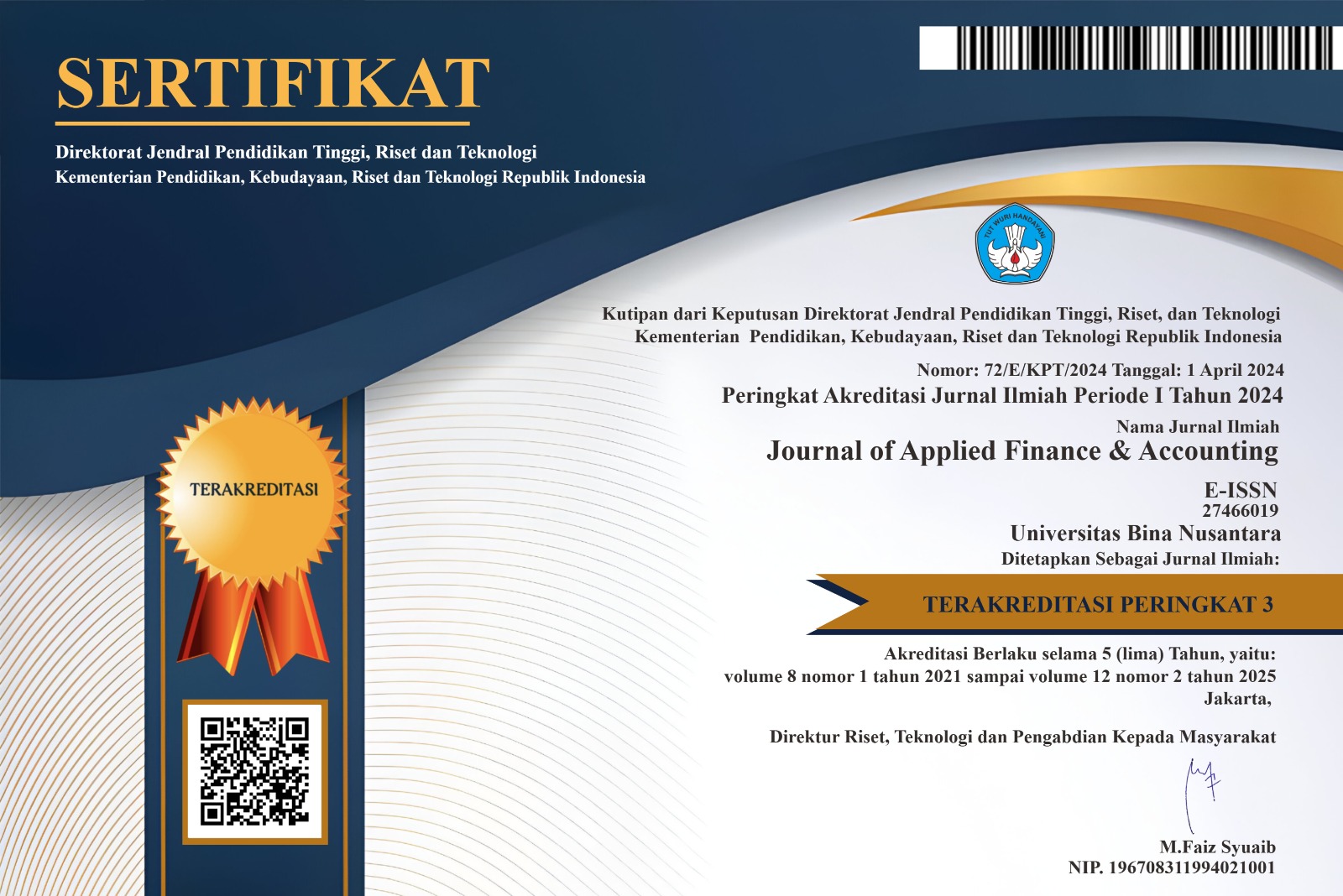THE EFFECTS OF INFLATION, RISK, AND MONEY SUPPLY ON MUTUAL FUNDS PERFORMANCE
DOI:
https://doi.org/10.21512/jafa.v7i2.6381Keywords:
Stock mutual funds performance, Inflation, Risk rate, Money supplyAbstract
This research aims to examine the effect of inflation, risk rate and money supply on the performance of stock mutual funds in the 2015-2017 period. This research uses purposive sampling and obtained 25 mutual funds stocks per year with a total sample of 75 samples. The analysis uses panel data regression with e-views version 9. The results show that inflation and money supply variable have a significant negative influence, while the risk rate variable has a significant positive influence. This shows that the performance of the stock mutual funds is influenced by macroeconomic factors such as inflation, the level of risk of each mutual fund product and the amount of money circulating in the community.
References
Badan Pusat Statistik. (2018), Jumlah Uang Beredar, diakses 20 Oktober 2018 dari www.bps.go.id
Bank Indonesia. (2018), Inflasi, diakses 20 Oktober 2018 dari www.bi.go.id
Bareksa. (2018), Return dan Tingkat Risiko Reksadana, diakses 20 Oktober 2018 dari www.bareksa.com
Brigham, H. (2010). Dasar-dasar Manajemen Keuangan Buku 1 (Edisi 11). Jakarta: Salemba Empat.
Indopremier. (2018), Cara Mengukur Risiko Reksadana, diakses 13 Oktober 2018 dari www.indopremier.com
Maulana, A. (2013). Pengaruh SBI, Jumlah Uang Beredar, Inflasi terhadap Kinerja. Jurnal Ilmu Manajemen Volume 1 No 3, 971-984.
Nurcahya, G. P., & Bandi. (2010). Reksa Dana di Indonesia: Analisis Kebijakan Alokasi Aset, Pemilikan Saham, dan Tingkat Risiko. Simposium Nasional Akuntansi XIII Purwokerto 2010.
Otoritas Jasa Keuangan. (2018), Produk Reksadana, diakses 20 Oktober 2018 dari www.ojk.go.id
Portalreksadana. (2018), Nilai Aktiva Bersih, diakses 23 Oktober 2018 dari www.portalreksadana.com
Sari, A. P., & Purwanto, A. (2012). Analisis Kebijakan Alokasi Aset, Kinerja Manajer Investasi dan Tingkat Risiko terhadap Kinerja Reksadana Saham di Indonesia. Diponegoro Journal of Accounting Volume 1, Nomor 1, Tahun 2012, 1-14.
Setiadi, S. P. (2013). Analisis Pengaruh Jumlah Uang yang Beredar Terhadap Kinerja Reksadana Saham di Indonesia Periode 2002-2012. 1-7.
Sholihat, F., AR, M. D., & Topowijono. (2015). Pengaruh Inflasi, Tingkat Suku Bunga Sertifikat Bank Indonesia & Indeks Harga Saham Gabungan terhadap Tingkat Pengembalian Reksadana Saham. Jurnal Administrasi Bisnis Vol. 21 No.1 April 2015, 1-7.
Sugiyono. (2015). Metode Penelitian Kuantitatif, Kualitatif, dan R&D. Bandung: CV. Alfabeta.
Tandelilin, E. (2001). Analisis Investasi dan Manajemen Portofolio. Edisi Pertama. Yogyakarta: BPFE.
Downloads
Published
Issue
Section
License
Authors who publish with this journal agree to the following terms:
Authors retain copyright and grant the journal right of first publication with the work simultaneously licensed under a Creative Commons Attribution License that allows others to share the work with an acknowledgement of the work's authorship and initial publication in this journal.
Authors are able to enter into separate, additional contractual arrangements for the non-exclusive distribution of the journal's published version of the work (e.g., post it to an institutional repository or publish it in a book), with an acknowledgement of its initial publication in this journal.
Authors are permitted and encouraged to post their work online (e.g., in institutional repositories or on their website) prior to and during the submission process, as it can lead to productive exchanges, as well as earlier and greater citation of published work (See The Effect of Open Access).





